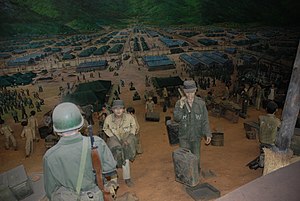
Geoje-do POW camp (Korean: 거제도 포로수용소) was a POW camp located in Geoje at the southernmost part of Gyeongsangnam-do, South Korea.[1]

Geoje-do POW camp (Korean: 거제도 포로수용소) was a POW camp located in Geoje at the southernmost part of Gyeongsangnam-do, South Korea.[1]
Geojedo Camp was built to hold prisoners shortly after the outbreak of the Korean War. Out of a total of 170,000 prisoners of war about 85% were from North Korea, and the rest from China.
In February 1952, Brigadier-General Francis Dodd was ordered to take command of the Geoje Camp after a U.S. soldier had been killed and 138 POWs wounded when the inmates of Compound 62 attacked an infantry battalion sent to forcibly screen POWs to determine whether they were military prisoners or civilian internees.
On 7 May 1952, General Dodd visited Compound 76 to listen to complaints aired by the Communist leaders of the camp. While standing near the gate of the compound, he and one of his subordinates were forcibly seized as the gate was opened to allow a work detail to pass through. The subordinate grabbed hold of a gatepost long enough for the American guards to rescue him, but Dodd was taken into the center of the camp and held hostage.
For the next 78 hours, Dodd was held captive. By his own admission he was treated well as hurried negotiations went on for his release. General Charles F. Colson was rushed to the island to take command, and he ordered a telephone rigged up to allow communication with Dodd. The main Communist demand was essentially an admission that UN forces had been responsible for bloodshed in the camps. This demand was granted by Colson and Dodd was eventually freed.
The camp was closed upon the signing of the 1953 armistice which ended the war. Tanks, trucks and other period armaments and artifacts are on display throughout the park as a memorial to the war which opened in 1997. The structure is meant to be reminiscent of the daily lives of the prisoners. The theme stresses the humane treatment of the internees.
War prisoners were also being interned in Daejeon, Incheon, Nonsan, Gwangju, Youngcheon, Busan, Masan and Daegu, and the UN introduced 6 villages in Gohyun gulf region which operated from 1950 to 1953.